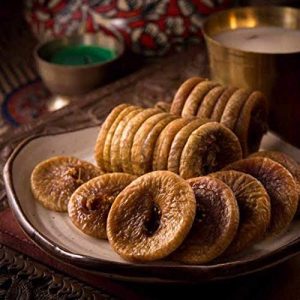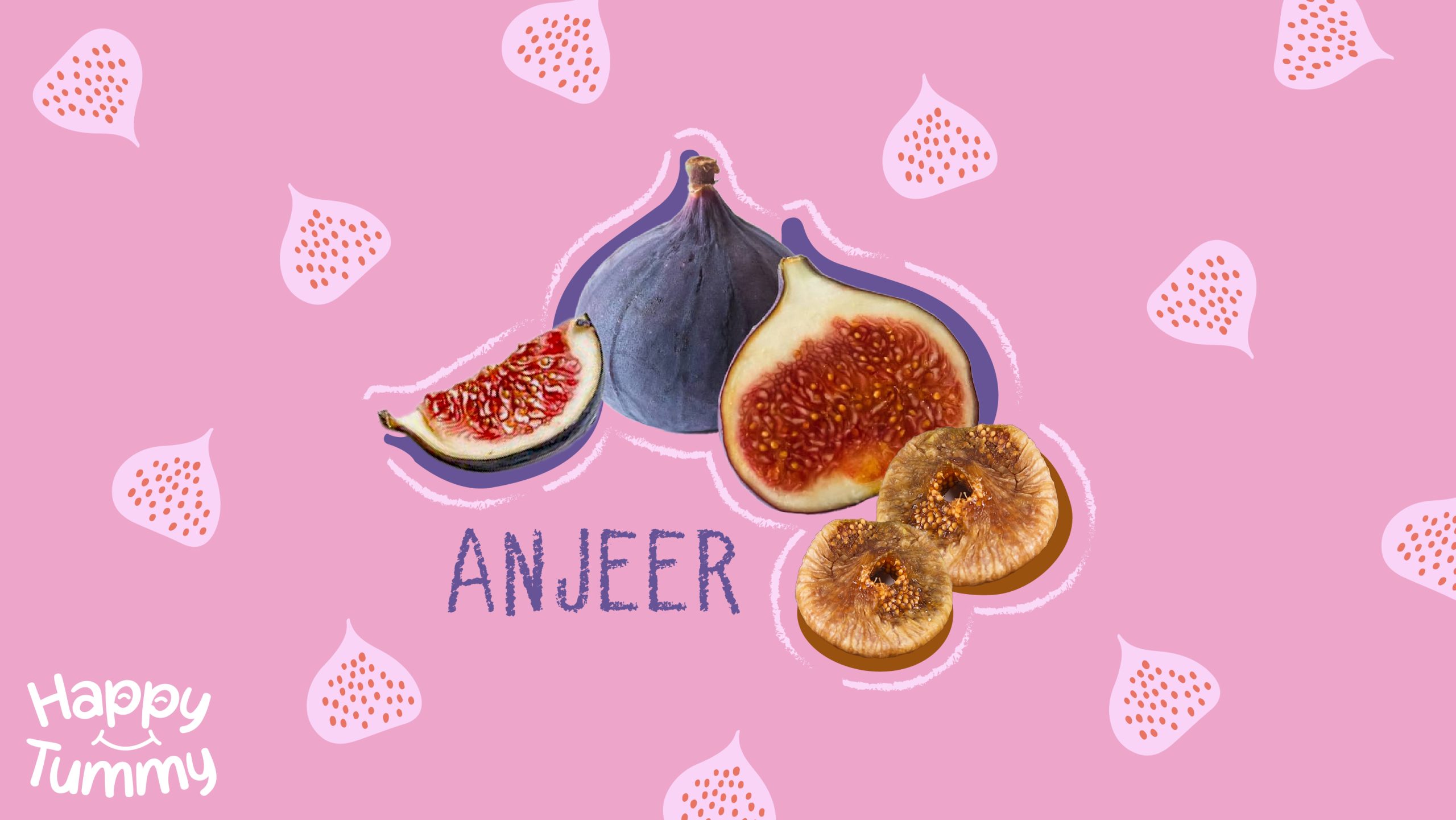Table of Contents
A for apple, B for ball, and F stands for a fig! Oops. Will we sing the alphabet song? Nopes. Simply to evoke that nostalgic vibe! Going home from school and asking moms what fig is all about will be something that 90s kids will easily connect to. The popularity of anjeer was not what it is now.
Not every kitchen dry fruit rack included a whole stack of it. But things are extremely different now. The kitchen storage is being overtaken by a variety of seeds, nuts, and spices as people are becoming more health conscious. And anjeer is the most adored, be it in the form of fruit or dried one.
A little pear- or bell-shaped blooming plant known as fig or anjeer as it is referred in India, is formally known as Ficus Carcia and is a member of the mulberry group.
Native to the Middle East, Asia, and Turkey, the fig is also widely farmed commercially in the United States and Spain. Maharashtra, Gujarat, Uttar Pradesh, Karnataka, and Coimbatore are among the Indian states where anjeer is grown for commercial purpose.
Anjeer – The Nature’s Candy
Fresh figs have a delectable mellow, sweet, slightly earthy, and subtle flavor. The peel gives the fruit a tangy mouth feel. The fruit’s richest and heartiest part is its pink flesh. It has a smooth, mushy, jam-like feel, and the lovely, crunchy seeds contribute to the texture’s appeal. The delicate flavour of fresh figs may amaze those habitual to the distinctive flavour of dried anjeer.
The flavour of dried anjeer is unique. Compared to its fresh counterpart, the texture is crispy and crunchy, and the flavour is stronger and sweeter. Although it is not as astringent or overpowering as dates, the center of dried figs is a seedy, dense pulp of sweetness. The fruit, which comes in various colours, including purple, red, green, and golden, is known as nature’s candy since it is rich in natural sugars.
Eating a fresh anjeer after a dried one is like comparing two sisters: one is outgoing and energetic, and is probably more attractive than the other, who is reserved, meek, and plain. While there are similarities in taste, there are also glaring differences.

Nutritional Value of Anjeer:
Anjeer is a fantastic supplement to a balanced diet because it is high in nutrients and has few calories. A serving size of 30g, or two figs, of dried figs, provides:
| NUTRIENTS | VALUE |
| Calories | 68 kcal/ 290KJ |
| Protein | 1.1 g |
| Fats | 0.5 g |
| Carbohydrate | 15.9 g |
| Fibre | 3 g |
| Potassium | 291 mg |
| Calcium | 75 mg |
| Magnesium | 24 mg |
| Iron | 1.26 mg |
Thus, anjeers are a potent source of the anti-inflammatory, antioxidant components carotenes, lutein, flavonoids, glucoside acids, and vitamins A, E, and K. These nutrients in anjeer helps detoxify free radicals, prevent various metabolic illnesses like diabetes, lower inflammation, and are suitable for heart health.
Dried figs are excellent in minerals like calcium, iron, magnesium, copper, potassium, selenium, and zinc. Iron is a crucial mineral for developing red blood cells and good health in general. In contrast, potassium helps maintain the balance of body fluids that control blood pressure and heart rate.
What are the benefits of Anjeer?
Anjeer has a variety of health benefits; try including these in your regimen to get the full range of these perks:
1. Anjeer Benefits for Bone Density
Figs are an excellent provider of potassium and calcium. Together, these minerals can increase bone density, decreasing the likelihood of fractures.
Research indicates that a diet high in potassium, in particular, can enhance bone health and lower bone turnover. Increasing calcium intake has been found to enhance the mineral structure of bones in children and adolescents.
Calcium is a crucial component of bones and plays a significant role in their structural integrity.
2. Anjeer Regulates Blood Sugar Levels
According to research, figs can lower blood sugar levels. Moreover, it improves insulin sensitivity and the bloodstream’s ability to absorb extra sugar, which helps regulate diabetes.
So it can be taken as an anjeer is suitable for people with diabetes.
3. Anjeer Benefits for Hair
Figs are rich in iron, potassium, magnesium, and vitamins A and E, all of which are essential for developing thicker hair. These nutrients promote the scalp’s blood flow to quicken hair growth.
For your hair, you can apply anjeer oil or powder. In cosmetics, fig extract is widely used to strengthen and improve hair hydration, cure knotted locks, make hair frizz-free, and make them appear shiny and healthy.
4. Anjeer Benefits for Weight Loss
Figs are a great snack if you’re trying to lose weight because they are high in fibre and relatively low in calories.
High-fiber foods like figs can assist you in feeling filled between mealtime and prevent munching when they are a component of a healthy diet.
Therefore, they might facilitate weight loss. Dietary fibres have been shown in numerous trials to aid with weight loss. Dried figs that have been soaked are quicker to digest and more nutrient-absorbent.
5. Anjeer Benefits in Pregnancy
In the first trimester of pregnancy, consuming figs can assist you with morning nausea. Additionally, it can assist in meeting your body’s nutritional needs when pregnant. A snack of 1-3 figs can help you throughout the day by keeping up your energy levels.
You may add one to your salad or consume one while taking a coffee break. Remember to have figs sparingly—no more than three per day—and in moderation.

Anjeer
6. Anjeer Benefits for Skin
Figs are magnificent fruits brimming with nutrients that are healthy for all skin types and abundant in richness. Consuming them or applying them as a homemade face mask will boost you.
7. An Excellent Treatment for Blisters
Traditional medicine has utilized anjeer extensively to treat various skin conditions, such as acne, dermatitis, and eczema. The fig tree’s latex exhibits an exceptional anti-wart quality without having any adverse impact on the skin.
Wrinkle-Free Skin-
Fig extract’s powerful anti-collagenase and antioxidant properties assist in reducing wrinkles and enhancing the appearance of the skin.
Numerous skin formulations that have been shown to lessen skin pigmentation, dehydration, and oil production frequently use fig extract.
Additionally, fig extract enhances skin moisture and is a natural treatment for wrinkles, acne, and sunburn.
Vibrant Skin-
The abundance of nutrients in anjeer, including vitamins C, E, and A, and potent antioxidants, are beneficial for nourishing the skin and regenerating skin cells.
You can make a paste of figs for a quick glow. Apply it to your face gently and leave it on for 15 minutes. Then, thoroughly rinse with lukewarm water to give your skin a healthy, radiant glow.
Additionally, the abundance of vitamins, minerals, and antioxidants supports blood circulation and maintains the skin’s pH level.
8. But Moderation is the Key!! Few Side Effects of Anjeer
On the other hand, it is obvious to overeat it, considering its numerous health benefits! You may then experience some of the adverse effects of figs.
Yes, there is a recommended daily intake of figs that you should follow to minimize any potential dangers. Keep reading to understand the possible side effects of figs to guide you to get the most out of these nutrient-dense nuts!
- Hard on the Tummy: Eating too many figs might make you feel heavy and give you stomach cramps.
- Bloating: Bloating can result from consuming too many figs briefly because they are high in fiber.
- Sun Sensitivity: Although figs are helpful in healing skin ailments and chronic skin conditions, they may injure the skin by making it more sensitive to ultraviolet light.
- Lessens Blood Sugar: Figs aid in regulating the body’s blood sugar levels. Diabetes patients benefit from this; however, people with low blood sugar levels may experience adverse effects. Stay away from eating figs if you have low blood sugar.
- Medications: High vitamin K levels in figs may conflict with blood thinners. Therefore, if you are using any blood-thinning treatments, it is recommended that you exercise caution when eating figs.
9. Storing Figs
Fresh figs have a five day maximum shelf life since they are highly perishable. Figs should be stored in dry conditions in the refrigerator below a soft cloth to extend their shelf life. Place the fruits out of direct sunlight and only wash them when willing for intake.
Dried figs should be kept far from warm areas like the kitchen counter and should instead be kept in an excellent, dark spot. The figs’ flavor will be preserved, and oxidation will be avoided if refrigerated.
10. Fig Recipe Ideas and Uses
- Soaked Anjeer: Figs or anjeer offer more health advantages if soaked in water. The soluble fiber in figs can be broken down by pre-soaking. Additionally, it aids in delaying the body’s absorption of glucose. Use mashed figs for spreads on toast, bread, pancakes, and cakes
- Slice and combine with figs, apricots, cherries, herbs, and walnuts in salads.
- Make it into a salsa or jam.
- By soaking figs in white wine, honey, and seasonings like cinnamon and bay herbs, you may make simmered figs.
- Add as a novel pizza topping that is placed over tofu mozzarella. Olive oil, sea salt, and mint go nicely with fig pizza, among other flavors.
- Add dried figs in pies, buns, and nut brownies.
- Crater out the figs and load them with flavored soya, almonds, seasonings, olive oil, and breadcrumbs.
- To make creamy fig smoothies, combine nectar, vanilla essence, sugar, coconut milk, and fig chunks. Put in a mold, and then freeze for the night.
- Add figs to strong alcoholic beverages like bourbon or wines.
- For a classic, sweet treat, dip figs in chocolate. Place these on top of desserts and milkshakes as a delicious topping if preferred.
- Desserts and confectionery can be made with figs as the base.
FAQs
Q1. How many anjeer could I consume per day?
However, since dried figs are heavy in calories, moderation is crucial. Keeping daily serving sizes to no more than 2-3 figs is advised. Also, dried figs are a nutritious snack for losing weight.
Q2. Who shouldn’t consume anjeer?
The phenolic chemicals of anjeer have clotting properties. Before including anjeer in your regular diet, those taking blood thinners should speak with their doctors. Anjeer consumption may reduce blood sugar. As a result, it’s essential to monitor blood sugar levels regularly.
Q3. Are diabetics able to consume anjeer?
Anjeer can be a part of a diabetic’s diet, but limiting how much they consume is best. Anjeer, or figs, are high in fiber and support healthy insulin action in diabetics.
Although dried Anjeer has high sugar content and may temporarily raise blood sugar levels, it is essential to monitor blood sugar levels frequently. Approximately 34 grams of sugar is present in one serving of dried anjeer.
Q4. Does anjeer work well for treating constipation?
As one of the best fruits to refuel and calm the intestines, dried figs are highly regarded. Given that it contains a sizable amount of soluble fibre, it functions as a natural laxative.
Strong evidence supports the claim that anjeer, which is high in fibre, can aid in proper bowel function, bulk up the stool, ease bowel movements, prevent constipation, and act as a natural treatment for digestive illnesses including stomach flu.
Q5. Does anjeer help you sleep better?
Yes, anjeer or figs encourage the body’s production of melatonin, which regulates sleep cycles and aids in treating insomnia. Additionally, it raises serotonin levels in the brain, lowers stress and anxiety, and enhances sleep.
















